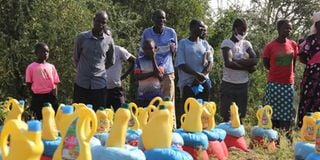Kenyans sacrifice food, family assets as Covid-19 bites

Residents of Nyamaji in Lambwe Ward, Suba North Constituency, wait to receive food donated by Homa Bay County for families affected by floods and the Covid-19 pandemic, July 6, 2020.
Tough economic times brought about by the Covid-19 pandemic have forced millions of Kenyans, in both rural and urban areas, to go without food.
The disease was first reported in Wuhan, China, on December 31, 2019 and in Kenya on March 13. The country has recorded over 80,000 infections and at least 1,400 deaths since then.
A study by the World Bank shows that 40 per cent of urban households and 38 per cent of rural ones have resorted to reducing food consumption following the closure of businesses and loss of jobs.
According to the 2019 national census, Kenya had a total population of 47.5 million people (30.25 million rural dwellers and 13.48 million urban dwellers), with 12.1 million households.
The World Bank says a total of 4.23 million households or 16.5 million Kenyans have been affected.
The data paints a worrying picture, with children suffering the same pain as adults, enduring hunger for many hours as parents watch helplessly.
“In May and June, in 40 per cent of the households, adults skipped meals at least once a week, and in 25 per cent of households, children had to do so. Adults went entire days without food in more than one in 10 households, and children did so in almost one in 10 households,” states the report released Thursday.
The study exposes the extent of food insecurity in Kenya, which was a concern even before the pandemic.
Female-headed homes
It further showed that female-headed households have been hit even harder.
“They were more likely to be worried about not having enough food to eat during the pandemic (70 per cent), compared to male-headed households (66 per cent), and more likely to have children going to bed hungry (20 per cent compared to 13 per cent),” the report states.
Regarding the closure of schools to contain the pandemic, the World Bank says the intentions were good but the move precipitated the situation especially among families where children heavily rely on school feeding programmes, particularly in arid and semi-arid regions (Asals).
“The lack of food can directly impact the ability of adults and children to undertake a normal, healthy and productive life, thus leading to malnutrition, stunting and human capital losses,” the report says.
Family assets
World Bank adds that some families resorted to selling household assets and withdrawing their savings as they continually cut non-critical non-food consumption.
The World Bank warns that these decisions will likely have deeper implications on households since some of the assets sold are productive.
“More than half of households used more than one coping strategy. Rural households used credit purchases more intensively (23 per cent) compared to urban ones (12 per cent), and some sold assets (15 and 11 per cent respectively),” the report says.
“The latter observation is particularly worrying as the sale of potentially productive assets can impact a household’s welfare in the long term.”





